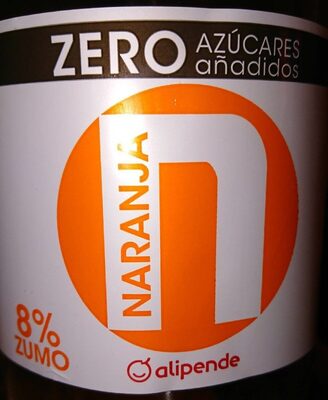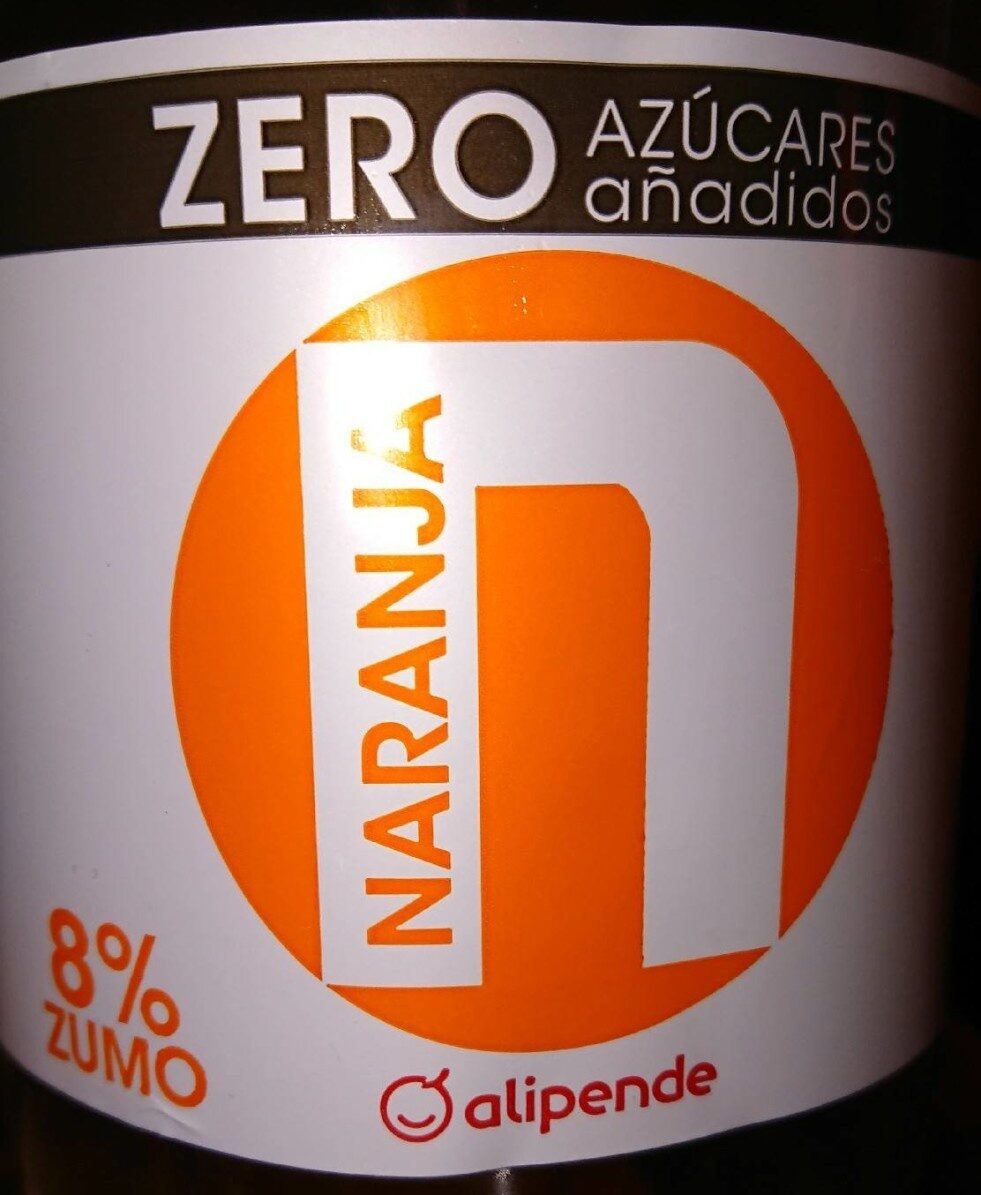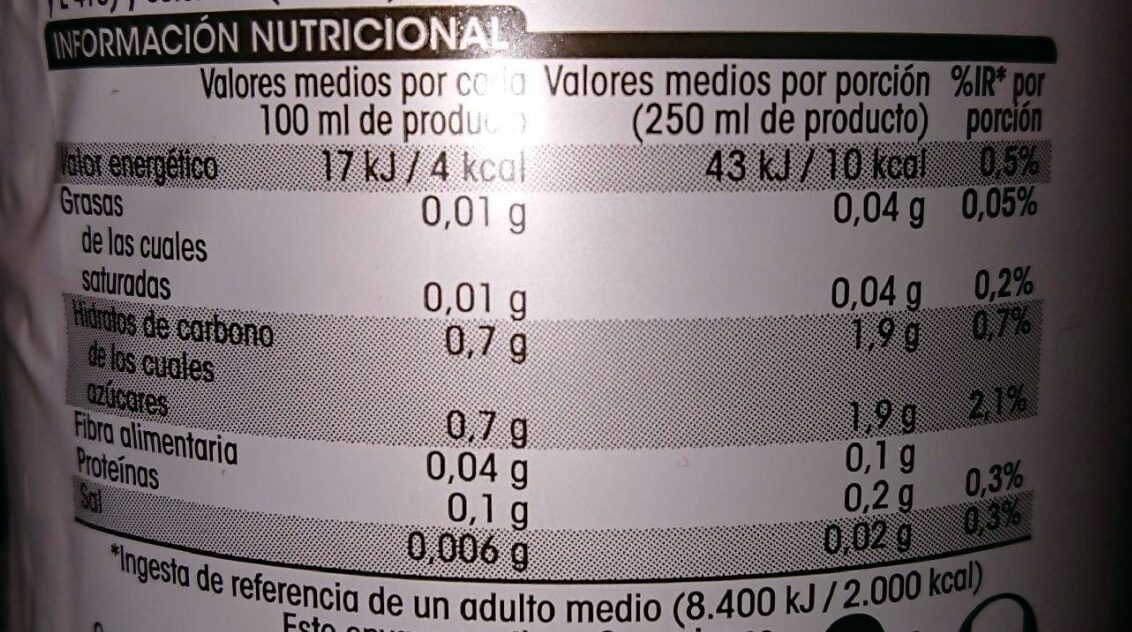Ajuda'ns a fer que la transparència alimentària sigui la norma!
Com a organització sense ànim de lucre, depenem de les vostres donacions per continuar informant els consumidors de tot el món sobre tot allò què mengen.
La revolució alimentària comença amb tu!
Naranja zero azúcares añadidos - Alipende - 2l
Naranja zero azúcares añadidos - Alipende - 2l
Aquesta pàgina del producte no està completa. Podeu ajudar a completar-la editant-la i afegint-hi més dades a partir de les fotos ja disponibles, o fent-ne més amb l'aplicació de androide o iPhone / iPad. Gràcies!
×
Codi de barres: 8421691699212 (EAN / EAN-13)
Nom comú: Bebida refrescante de zumo de frutas con edulcorantes, sin azúcares añadidos
Quantitat: 2l
Marques: Alipende
Categories: Begudes, Begudes carbonatades, Beguda gasosa de fruita, en:Carbonated fruit soft drink with less than 10% of fruit juice
Etiquetes, certificacions, premis: Conté una font de fenilalanina, Sense sucre afegit, Amb edulcorants
Països on es va vendre: Espanya
Matching with your preferences
Salut
Ingredients
-
17 ingredients
: Agua carbonatada, zumo de naranja a partir de concentrado (8%), acidulante (ácido cítrico), antioxidante (ácido ascórbico), edulcorantes (aspartamo, acesulfamo k), conservador (sorbato potásico), aroma, estabilizantes (E-440, E410), colorante (E-160a).
Processament d'aliments
-
Aliments ultra processats
Elements que indiquen que el producte està al grup 4 - Aliments i begudes ultraprocessats:
- Additiu: E160a - Carotè
- Additiu: E410 - Goma de garrofí
- Additiu: E440 - Pectina
- Additiu: E950 - Acesulfam K
- Additiu: E951 - Aspartam
- Ingredient: Color
- Ingredient: Aromes
- Ingredient: Edulcorant
Els productes alimentaris es classifiquen en 4 grups segons el seu grau de processament:
- Aliments no processats o mínimament processats
- Ingredients culinaris processats
- Aliments processats
- Aliments ultra processats
La determinació del grup es fa en funció de la categoria del producte i dels ingredients que conté.
Additius
-
E160a - Carotè
Carotene: The term carotene -also carotin, from the Latin carota, "carrot"- is used for many related unsaturated hydrocarbon substances having the formula C40Hx, which are synthesized by plants but in general cannot be made by animals -with the exception of some aphids and spider mites which acquired the synthesizing genes from fungi-. Carotenes are photosynthetic pigments important for photosynthesis. Carotenes contain no oxygen atoms. They absorb ultraviolet, violet, and blue light and scatter orange or red light, and -in low concentrations- yellow light. Carotenes are responsible for the orange colour of the carrot, for which this class of chemicals is named, and for the colours of many other fruits, vegetables and fungi -for example, sweet potatoes, chanterelle and orange cantaloupe melon-. Carotenes are also responsible for the orange -but not all of the yellow- colours in dry foliage. They also -in lower concentrations- impart the yellow coloration to milk-fat and butter. Omnivorous animal species which are relatively poor converters of coloured dietary carotenoids to colourless retinoids have yellowed-coloured body fat, as a result of the carotenoid retention from the vegetable portion of their diet. The typical yellow-coloured fat of humans and chickens is a result of fat storage of carotenes from their diets. Carotenes contribute to photosynthesis by transmitting the light energy they absorb to chlorophyll. They also protect plant tissues by helping to absorb the energy from singlet oxygen, an excited form of the oxygen molecule O2 which is formed during photosynthesis. β-Carotene is composed of two retinyl groups, and is broken down in the mucosa of the human small intestine by β-carotene 15‚15'-monooxygenase to retinal, a form of vitamin A. β-Carotene can be stored in the liver and body fat and converted to retinal as needed, thus making it a form of vitamin A for humans and some other mammals. The carotenes α-carotene and γ-carotene, due to their single retinyl group -β-ionone ring-, also have some vitamin A activity -though less than β-carotene-, as does the xanthophyll carotenoid β-cryptoxanthin. All other carotenoids, including lycopene, have no beta-ring and thus no vitamin A activity -although they may have antioxidant activity and thus biological activity in other ways-. Animal species differ greatly in their ability to convert retinyl -beta-ionone- containing carotenoids to retinals. Carnivores in general are poor converters of dietary ionone-containing carotenoids. Pure carnivores such as ferrets lack β-carotene 15‚15'-monooxygenase and cannot convert any carotenoids to retinals at all -resulting in carotenes not being a form of vitamin A for this species-; while cats can convert a trace of β-carotene to retinol, although the amount is totally insufficient for meeting their daily retinol needs.Origen: Wikipedia (Anglès)
-
E202 - Sorbat de potassi
Potassium sorbate: Potassium sorbate is the potassium salt of sorbic acid, chemical formula CH3CH=CH−CH=CH−CO2K. It is a white salt that is very soluble in water -58.2% at 20 °C-. It is primarily used as a food preservative -E number 202-. Potassium sorbate is effective in a variety of applications including food, wine, and personal-care products. While sorbic acid is naturally occurring in some berries, virtually all of the world's production of sorbic acid, from which potassium sorbate is derived, is manufactured synthetically.Origen: Wikipedia (Anglès)
-
E330 - Acid citric
Citric acid: Citric acid is a weak organic acid that has the chemical formula C6H8O7. It occurs naturally in citrus fruits. In biochemistry, it is an intermediate in the citric acid cycle, which occurs in the metabolism of all aerobic organisms. More than a million tons of citric acid are manufactured every year. It is used widely as an acidifier, as a flavoring and chelating agent.A citrate is a derivative of citric acid; that is, the salts, esters, and the polyatomic anion found in solution. An example of the former, a salt is trisodium citrate; an ester is triethyl citrate. When part of a salt, the formula of the citrate ion is written as C6H5O3−7 or C3H5O-COO-3−3.Origen: Wikipedia (Anglès)
-
E410 - Goma de garrofí
Locust bean gum: Locust bean gum -LBG, also known as carob gum, carob bean gum, carobin, E410- is a thickening agent and a gelling agent used in food technology.Origen: Wikipedia (Anglès)
-
E440 - Pectina
Pectin: Pectin -from Ancient Greek: πηκτικός pēktikós, "congealed, curdled"- is a structural heteropolysaccharide contained in the primary cell walls of terrestrial plants. It was first isolated and described in 1825 by Henri Braconnot. It is produced commercially as a white to light brown powder, mainly extracted from citrus fruits, and is used in food as a gelling agent, particularly in jams and jellies. It is also used in dessert fillings, medicines, sweets, as a stabilizer in fruit juices and milk drinks, and as a source of dietary fiber.Origen: Wikipedia (Anglès)
-
E950 - Acesulfam K
Acesulfame potassium: Acesulfame potassium - AY-see-SUL-faym-, also known as acesulfame K -K is the symbol for potassium- or Ace K, is a calorie-free sugar substitute -artificial sweetener- often marketed under the trade names Sunett and Sweet One. In the European Union, it is known under the E number -additive code- E950. It was discovered accidentally in 1967 by German chemist Karl Clauss at Hoechst AG -now Nutrinova-. In chemical structure, acesulfame potassium is the potassium salt of 6-methyl-1‚2,3-oxathiazine-4-3H--one 2‚2-dioxide. It is a white crystalline powder with molecular formula C4H4KNO4S and a molecular weight of 201.24 g/mol.Origen: Wikipedia (Anglès)
-
E951 - Aspartam
Aspartame: Aspartame -APM- is an artificial non-saccharide sweetener used as a sugar substitute in some foods and beverages. In the European Union, it is codified as E951. Aspartame is a methyl ester of the aspartic acid/phenylalanine dipeptide. A panel of experts set up by the European Food Safety Authority concluded in 2013 that aspartame is safe for human consumption at current levels of exposure. As of 2018, evidence does not support a long-term benefit for weight loss or in diabetes. Because its breakdown products include phenylalanine, people with the genetic condition phenylketonuria -PKU- must be aware of this as an additional source.It was first sold under the brand name NutraSweet. It was first made in 1965, and the patent expired in 1992. It was initially approved for use in food products by the U.S. Food and Drug Administration -FDA- in 1981. The safety of aspartame has been the subject of several political and medical controversies, United States congressional hearings, and Internet hoaxes.Origen: Wikipedia (Anglès)
Anàlisi dels ingredients
-
Pot contenir oli de palma
Ingredients que poden contenir oli de palma: E160a
-
Pot ser vegà
Ingredients que potser no són vegans: Aromes, E160a
-
Pot ser vegetarià
Ingredients que potser no són vegetarians: Aromes, E160a
-
Detalls de l'anàlisi dels ingredients
: Agua carbonatada, zumo de naranja a partir de concentrado 8%, acidulante (ácido cítrico), antioxidante (ácido ascórbico), edulcorantes (aspartamo, acesulfamo k), conservador (sorbato potásico), aroma, estabilizantes (e440, e410), colorante (e160a)- Agua carbonatada -> en:carbonated-water - vegan: yes - vegetarian: yes - ciqual_food_code: 18066 - percent_min: 45 - percent_max: 92
- zumo de naranja a partir de concentrado -> en:orange-juice-from-concentrate - vegan: yes - vegetarian: yes - ciqual_food_code: 2012 - percent_min: 8 - percent: 8 - percent_max: 8
- acidulante -> en:acid - percent_min: 0 - percent_max: 8
- ácido cítrico -> en:e330 - vegan: yes - vegetarian: yes - percent_min: 0 - percent_max: 8
- antioxidante -> en:antioxidant - percent_min: 0 - percent_max: 8
- ácido ascórbico -> en:e300 - vegan: yes - vegetarian: yes - percent_min: 0 - percent_max: 8
- edulcorantes -> en:sweetener - percent_min: 0 - percent_max: 8
- aspartamo -> en:e951 - vegan: yes - vegetarian: yes - percent_min: 0 - percent_max: 8
- acesulfamo k -> en:e950 - vegan: yes - vegetarian: yes - percent_min: 0 - percent_max: 4
- conservador -> en:preservative - percent_min: 0 - percent_max: 8
- sorbato potásico -> en:e202 - vegan: yes - vegetarian: yes - percent_min: 0 - percent_max: 8
- aroma -> en:flavouring - vegan: maybe - vegetarian: maybe - percent_min: 0 - percent_max: 5
- estabilizantes -> en:stabiliser - percent_min: 0 - percent_max: 5
- e440 -> en:e440a - vegan: yes - vegetarian: yes - percent_min: 0 - percent_max: 5
- e410 -> en:e410 - vegan: yes - vegetarian: yes - percent_min: 0 - percent_max: 2.5
- colorante -> en:colour - percent_min: 0 - percent_max: 5
- e160a -> en:e160a - vegan: maybe - vegetarian: maybe - from_palm_oil: maybe - percent_min: 0 - percent_max: 5
Nutrició
-
Qualitat nutricional mitjana
⚠ ️Atenció: la quantitat de fruita, verdura i fruits secs no s'especifica a l'etiqueta, s'ha fet una estimació a partir de la llista d'ingredients: 8Aquest producte es considera una beguda per al càlcul de la Nutri-Score.
Punts positius: 0
- Proteïnes: 0 / 5 (valor: 0.1, valor arrodonit: 0.1)
- Fibra: 0 / 5 (valor: 0.04, valor arrodonit: 0.04)
- Fruites, verdures, fruits secs i olis de colza/nou/oliva: 0 / 10 (valor: 8, valor arrodonit: 8)
Punts negatius: 2
- Energia: 1 / 10 (valor: 17, valor arrodonit: 17)
- Sucres: 1 / 10 (valor: 0.7, valor arrodonit: 0.7)
- Greixos saturats: 0 / 10 (valor: 0.01, valor arrodonit: 0)
- Sodi: 0 / 10 (valor: 2.4, valor arrodonit: 2.4)
Els punts per proteïnes es compten perquè els punts negatius són inferiors a 11.
Puntuació nutricional: (2 - 0)
Nutri-Score:
-
Nivells de nutrients
-
Greix en baixa quantitat (0.01%)
Què us cal saber- Un alt consum de greixos, especialment de greixos saturats, pot augmentar el colesterol, que augmenta el risc de patir malalties del cor.
Recomanació: Reduïu el consum de greixos i greixos saturats- Trieu productes amb menys greixos i greixos saturats.
-
Àcid gras saturat en baixa quantitat (0.01%)
Què us cal saber- Un alt consum de greixos, especialment de greixos saturats, pot augmentar el colesterol, que augmenta el risc de patir malalties del cor.
Recomanació: Reduïu el consum de greixos i greixos saturats- Trieu productes amb menys greixos i greixos saturats.
-
Sucre en baixa quantitat (0.7%)
Què us cal saber- Un alt consum de sucre pot provocar augment de pes i càries dental. També augmenta el risc de patir diabetis tipus 2 i malalties cardiovasculars.
Recomanació: Limitau el consum de sucre i de begudes ensucrades- Les begudes ensucrades (com ara refrescos, begudes de fruites i sucs i nèctars de fruites) s'han de limitar tant com sigui possible (no més d'1 got al dia).
- Triau productes amb menor contingut de sucre i reduïu el consum de productes amb sucres afegits.
-
Sal comuna en baixa quantitat (0.006%)
Què us cal saber- Un alt consum de sal (o sodi) pot provocar un augment de la pressió arterial, que pot augmentar el risc de patir malalties del cor i ictus.
- Moltes persones que tenen hipertensió no ho saben, ja que sovint no en tenen símptomes.
- La majoria de la gent consumeix massa sal (de 9 a 12 grams de mitjana al dia), al voltant del doble del nivell màxim d'ingesta recomanat.
Recomanació: Limitau la ingesta de sal i d'aliments rics en sal- Reduïu la sal que emprau quan cuinau, i no afegiu sal a taula.
- Limiteu el consum d'aperitius salats i trieu productes amb menor contingut de sal.
-
-
Informació nutricional
Informació nutricional Com es ven
per 100 g/100 mlCom es ven
per porció (250ml)Comparat amb: Begudes carbonatades Energia 17 kj
(4 kcal)42,5 kj
(10 kcal)-76% Greix 0,01 g 0,025 g +276% Àcid gras saturat 0,01 g 0,025 g +1.353% Hidrats de carboni 0,7 g 1,75 g -82% Sucre 0,7 g 1,75 g -81% Fiber 0,04 g 0,1 g +215% Proteïna 0,1 g 0,25 g +513% Sal comuna 0,006 g 0,015 g -73% Fruits‚ vegetables‚ nuts and rapeseed‚ walnut and olive oils (estimate from ingredients list analysis) 8 % 8 %
Entorn
-
Eco-puntuació C - Impacte ambiental moderat
El Eco-Score és una puntuació experimental que resumeix els impactes ambientals dels productes alimentaris.→ L'Eco-Score es va desenvolupar inicialment a França i s'està ampliant per a altres països europeus. La fórmula Eco-Score està subjecta a canvis, ja que es millora periòdicament per fer-la més precisa i més adequada per a cada país.Anàlisi del cicle de vida
-
Impacte mitjà dels productes de la mateixa categoria: B (Score: 73/100)
Categoria: Fruit soft drink, carbonated (10-50% of fruit juice), with sugar
Categoria: Fruit soft drink, carbonated (10-50% of fruit juice), with sugar
- Puntuació ambiental PEF ( petjada ambiental de l'aliment ): 0.08 (com més baixa sigui la puntuació, menor serà l'impacte)
- incloent l'impacte sobre el canvi climàtic: 0.44 kg CO₂ eq/kg del producte
Etapa Impacte Agricultura
8.6 %Processament
4.9 %Empaquetament
51.7 %Transport
19.7 %Distribució
11.9 %Consum
3.3 %
Bonificacions i punts negatius
-
Falta informació sobre l'origen dels ingredients
Punts negatius: -5
⚠ ️ L'origen dels ingredients d'aquest producte no està indicat.
Si estan indicats a l'embalatge, podeu modificar la fitxa del producte i afegir-los.
Si sou el fabricant d'aquest producte, podeu enviar-nos la informació amb la nostra plataforma gratuïta per a productors.
-
Falta informació sobre l'embalatge d'aquest producte
Punts negatius: -15
⚠ ️ La informació sobre l'embalatge d'aquest producte no està completada.⚠ ️ Per a un càlcul més precís de l'Eco-Score, podeu modificar la pàgina del producte i afegir-los.
Si sou el fabricant d'aquest producte, podeu enviar-nos la informació amb la nostra plataforma gratuïta per a productors.
Eco-Score per a aquest producte
-
Impacte per a aquest producte: C (Score: 53/100)
Producte: Naranja zero azúcares añadidos - Alipende - 2l
Puntuació de l'anàlisi del cicle de vida: 73
Suma de bonificacions i punts negatius: -20
Puntuació final: 53/100
-
Petjada de carboni
-
Equivalent a conduir 0.2 km en un cotxe de gasolina
44 g de CO² per cada 100 g de producte
La xifra d'emissions de carboni prové de la base de dades Agribalyse d'ADEME, per a la categoria: Fruit soft drink, carbonated (10-50% of fruit juice), with sugar (Font: Base de dades ADEME Agribalyse)
Etapa Impacte Agricultura
2.2 %Processament
4.7 %Empaquetament
40.5 %Transport
43.0 %Distribució
8.1 %Consum
1.5 %
Empaquetament
-
Falta informació sobre l'embalatge d'aquest producte
⚠ ️ La informació sobre l'embalatge d'aquest producte no està completada.Take a photo of the recycling information Take a photo of the recycling information
Transport
-
Orígens dels ingredients
Falta informació sobre l'origen dels ingredients
⚠ ️ L'origen dels ingredients d'aquest producte no està indicat.
Si estan indicats a l'embalatge, podeu modificar la fitxa del producte i afegir-los.
Si sou el fabricant d'aquest producte, podeu enviar-nos la informació amb la nostra plataforma gratuïta per a productors.Add the origins of ingredients for this product Add the origins of ingredients for this product
Report a problem
-
Incomplete or incorrect information?
Category, labels, ingredients, allergens, nutritional information, photos etc.
If the information does not match the information on the packaging, please complete or correct it. Open Food Facts is a collaborative database, and every contribution is useful for all.
Fonts de dades
Producte afegit per kiliweb
Última modificació de la pàgina del producte per alia.
La pàgina del producte, també editada per roboto-app, yuka.UlAwRVNJWUh1TnNLbjlzNy9CejRwUE50MnE2cFhXQzljY01USWc9PQ.









